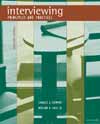 |  Interviewing: Principles and Practices, 11/e Charles J. Stewart,
Purdue University--West Lafayette
William B. Cash,
National Louis University--Evanston
Questions and Their Uses
Chapter SummaryQuestions are the tools of the trade for both parties in interviews. If you know question types, unique uses, and advantages and disadvantages, you can develop considerable interviewing skill and enjoy the experiences.
You have a limitless variety of question tools to choose from, and each tool has unique characteristics, capabilities, and pitfalls. Knowing which question to select and how to use it is essential for interviewing effectively and efficiently. Each question has three characteristics: (1) open or closed, (2) primary or secondary, and (3) neutral or leading. Open questions are designed to discover large amounts of information, while closed questions are designed to gain specific bits of information. Primary questions open up topics and subtopics, while secondary questions probe into answers for more information, explanations, clarifications, and verifications. Neutral questions give respondents freedom to answer as they wish, while leading questions nudge or shove respondents toward answers interviewers want to hear.
Phrasing questions is essential to get the information needed. If you phrase questions carefully and think before asking, you can avoid common question pitfalls such as the bipolar trap, open-to-closed switch, double-barreled inquisition, leading push, guessing game, yes (no) response, curious probe, quiz show, and don't ask, don't tell.
|
|



 2006 McGraw-Hill Higher Education
2006 McGraw-Hill Higher Education